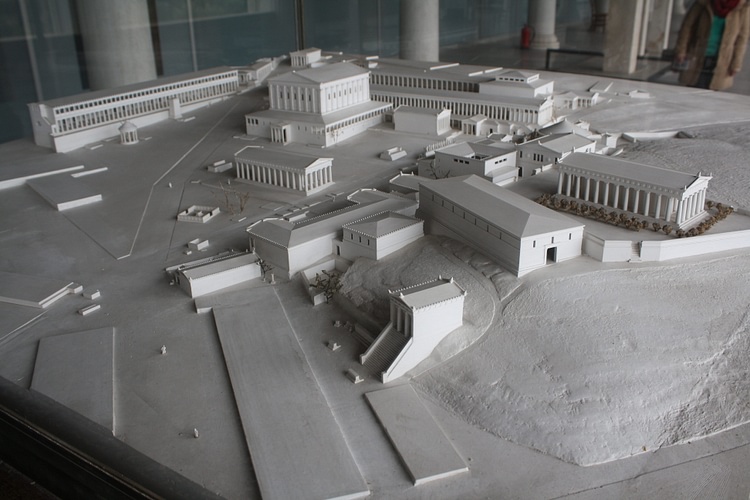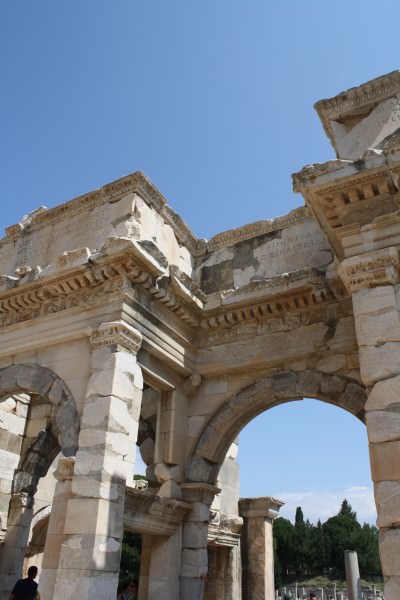Agora › Ancient History
Agora
DEFINITION AND ORIGINS
by Joshua J. Mark
published on 02 September 2009
published on 02 September 2009

The word Agora (pronounced 'Ah-go-RAH') is Greek for 'open place of assembly' and, early in the history of Greece, designated the area in the city where free-born citizens could gather to hear civic announcements, muster for military campaigns or discuss politics. Later the Agora defined the open-air, often tented, marketplace of a city (as it still does in Greek) where merchants had their shops and where craftsmen made and sold their wares. The original Agora of Athens was located below the Acropolis near the building which today is known as The Thesion and open-air markets are still held in that same location in the modern day.
TRADERS IN THE AGORA
Retail traders (known as kapeloi ) served as middle-men between the craftsmen and the consumer but were largely mistrusted in ancient times as unnecessary parasites (in his Politics Aristotle states that the kapeloi served a “kind of exchange which is justly censured; for it is unnatural and a mode by which men unfairly gain from one another”). These retail traders were mostly metics (not free-born citizens of the city, today known as 'legal aliens') while the craftsmen could be metics, citizens or even freed slaves who had become skilled artisans.
THE ATHENIAN AGORA HOSTED ALL MANNER OF MERCHANTS, FROM CONFECTIONERS TO SLAVE TRADERS.
In the Agora of Athens there were confectioners who made pastries and sweets, slave-traders, fishmongers, vintners, cloth merchants, shoe-makers, dress makers, and jewelry purveyors. A special separate 'potters market' was reserved for the buying and selling of cookware as that was considered solely the provenance of women and was frequented by female slaves on task for their mistresses or by the poorer wives and daughters of Athens.
PHILOSOPHERS & THE AGORA
It was in the Agora of Athens that the great philosopher Socrates questioned the market-goers on their understanding of the meaning of life, attracting a crowd of Athenian youth who enjoyed seeing the more pretentious of their elders made fools of. In this marketplace, one day, the young poet Aristocles son of Ariston heard Socrates speaking, went and burned all his works, and became the philosopher known as Plato. His philosophical dialogues, coupled with his founding of the Academy, the first University, and his role as the teacher of Aristotle who then was tutor to Alexander the Great, changed western philosophy.A contemporary of Plato's, Diogenes of Sinope, lived in a tub in the Agora and followed Socrates' example of questioning the Athenians on their understanding of the more important aspects of life. Diogenes is well known for searching for an honest man (though, actually, he claimed he was searching for a real human being) by holding a candle or lantern to people's faces in the agora.

Agora Gate, Ephesos
THE ROMAN AGORA
In Rome the agora would serve in much the same way as it did in Greek city-states such as Athens but was known as The Forum (literally `the place outdoors'). As in Greece, the women frequented the out-door market to shop while the men would meet there to discuss politics or events of the day. Among the most popular commodities of the Roman market was silk, both in the time of the Roman Republic and during the Roman Empire. So popular was silk that laws needed to be enacted to encourage modesty among the women of Rome who wore the sheer fabric daily to public events. In time, these laws were also applied to men who came to appreciate silk as much as the women. Latin writers frequently make fun of those their fellow citizens and their behavior at market. The Roman satirist Juvenal and the poet Horace, as well as other writers, found much of their inspiration in watching and listening to those who gathered for shopping in the open-air market.
LICENSE:
Article based on information obtained with permission from the Website Ancient History Encyclopedia
Content is available under License Creative Commons: Attribution-NonCommercial-ShareAlike 3.0 Unported. CC-BY-NC-SA License